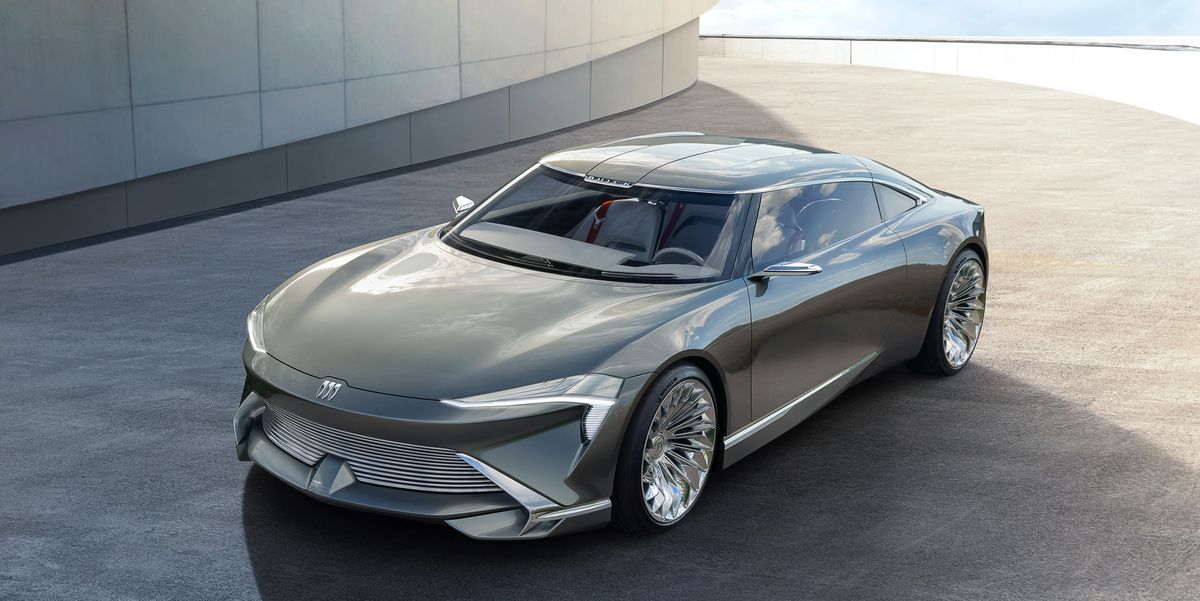Buick Wildcat EV Concept Previews a Design Makeover for the GM Brand

The Buick Wildcat EV concept is a pure design study that indicates the brand’s future styling direction. The Buick lineup will consist entirely of electric vehicles by 2030. Buick EVs will be sold under the Electra sub-brand.
Buick has just revealed the Wildcat EV concept, a design exercise intended to establish the brand’s future styling direction with a particular focus on its upcoming electric vehicles. Curiously, Buick laid its future look on a low, wide, four-seat fastback coupe rather than on an SUV, though the brand is currently made up solely of SUVs—and will remain that way, we were told.
While neither the Wildcat EV nor anything like it will go into production, the execs on hand for our private viewing confirmed that the Buick lineup will be composed only of electric vehicles by 2030, all of them SUVs. Those EVs will fall under a new sub-brand called Electra—which, ironically, is the name Buick affixed to its largest gas-swilling models for about 30 years starting in 1959.
While the Wildcat concept is touted as an EV, it was neither designed nor sized to accommodate GM’s Ultium battery pack—nor any battery pack, for that matter. During our visit, Sharon Gauci, executive director of global Buick-GMC design, emphasized that the Wildcat’s mission is to inform the styling of upcoming Buicks by giving the brand’s designers a clear design direction that they can apply to production vehicles. “This was a tremendous opportunity to come up with what a new design language and aesthetic for Buick will feel like,” she said.
The Wildcat’s design team started by defining a new look for the future Electra EV line. Those elements will in turn will be phased into Buick’s upcoming internal-combustion-powered SUVs. In fact, the team that created the Wildcat EV is also working on future production Buicks, so the new-age design influence is already at work in the studio.
Buick has confirmed that the first Electra EV SUV will be revealed sometime in 2024; we expect it to go on sale as a 2025 model. That vehicle, we were told, will be based on the same platform as the upcoming Cadillac Lyriq and will be similar in size. That means it could have a 100.0-kWh Ultium battery pack in its floor and a driving range of more than 300 miles; both single- and dual-motor models will likely be offered.
“Not Trying to Be Trendy”
If you’re thinking that the Wildcat doesn’t look like an EV, then the designers have done the job they set out to do. According to Gauci, many of today’s EVs are faceless—they’ve done away with traditional grilles because they can. Buick EVs won’t. Electras will show the world a well-defined face like the Wildcat’s, with thin, high-mounted headlights and a prominent grille made of tightly space horizontal bars—bright metal on some models. The Wildcat’s softly rounded body sides are simple and elegant, said Therese Pinazzo, Buick exterior and interior design manager, because “the forms are more timeless; we’re not trying to be trendy.” Like the new face, those body-side shapes will be echoed in future Buicks, both EVs and gasoline models. Seen from the rear, a pair of beautiful taillamps wrap up the sides of the rear glass, indicating there will be some artful taillamp designs on future Buicks as well.
It’s no surprise that the new look also includes a major update to the well-known Buick logo, which has historically been made up of three slim connected shields—mini family crests—inside a circle. The shields have now broken out of circle prison and stand separated—free, finally!—on the nose of the Wildcat, lit from behind. It’ll likely not be illuminated on production vehicles, but it does look far more modern. The new badge will show up on Buicks starting next year.
Like most concept vehicles intended purely as design studies, the Wildcat contains not only visual cues that will be interpreted for production models but also fanciful ideas that will never see the light of day. The Wildcat’s interior is show-car fancy, with exotic-looking seats that would be appropriate in a Ferrari, maybe, but in a Buick SUV? Not so much. When you pull the door open, a section of the roof pops up to ease your entry; that’s sure to be another nonstarter.
The interior’s big reach is the idea of the car as mood ring: the designers propose using biometrics to monitor your feelings and vital signs. Based on that data, your vehicle would decide if it needed to automatically turn on features like aroma therapy and seat massage to bring you to back to a Zen state when, say, a cabbie cuts you off in downtown traffic or that jerk up ahead is texting when the light turns green. Good luck with that.
Much more likely to make it into production are the large, curved screen sweeping across most of the instrument panel that’s not unlike the one in the current Caddy Escalade, and the flat-bottom steering wheel that’s in, well, everything from VWs to Bugattis.
Buick’s new look will debut first on a conventionally powered gas-engine SUV that will be revealed later this year and go into production in 2023 as a 2024 model. The first Electra EV will roll out of an assembly plant a year later.
This content is created and maintained by a third party, and imported onto this page to help users provide their email addresses. You may be able to find more information about this and similar content at piano.io



